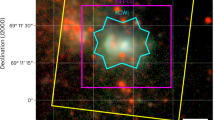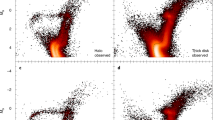Abstract
The ages of the oldest stars in the Galaxy indicate when star formation began, and provide a minimum age for the Universe. Radioactive dating of meteoritic material1 and stars2 relies on comparing the present abundance ratios of radioactive and stable nuclear species to the theoretically predicted ratios of their production. The radioisotope 232Th (half-life 14 Gyr) has been used to date Galactic stars2,3,4, but it decays by only a factor of two over the lifetime of the Universe. 238U (half-life 4.5 Gyr) is in principle a more precise age indicator, but even its strongest spectral line, from singly ionized uranium at a wavelength of 385.957 nm, has previously not been detected in stars4,5,6,7. Here we report a measurement of this line in the very metal-poor star CS31082-0018, a star which is strongly overabundant in its heavy elements. The derived uranium abundance, log(U/H) = -13.7 ± 0.14 ± 0.12 yields an age of 12.5 ± 3 Gyr, though this is still model dependent. The observation of this cosmochronometer gives the most direct age determination of the Galaxy. Also, with improved theoretical and laboratory data, it will provide a highly precise lower limit to the age of the Universe.
This is a preview of subscription content, access via your institution
Access options
Subscribe to this journal
Receive 51 print issues and online access
$199.00 per year
only $3.90 per issue
Buy this article
- Purchase on Springer Link
- Instant access to full article PDF
Prices may be subject to local taxes which are calculated during checkout

Similar content being viewed by others
References
Tilton, G. R. in Meteorites and the Early Solar System (eds Kerridge, J. F. & Matthews, M. S.) 249–258 (Univ. Arizona Press, Tucson, 1988).
Butcher, H. R. Thorium in G-dwarfs as a chronometer for the Galaxy. Nature 328, 127–131 (1987).
François, P., Spite, M. & Spite, F. On the galactic age problem: Determination of the [Th/Eu] ratio in halo stars. Astron. Astrophys. 274, 821–824 (1993).
Cowan, J. J. et al. r-process abundances and chronometers in metal-poor stars. Astrophys. J. 521, 194–205 (1999).
Westin, J., Sneden, C., Gustafsson, B. & Cowan, J. J. The r-process enriched low-metallicity giant HD 115444. Astrophys. J. 530, 783–799 (2000).
Sneden, C. et al. Evidence of multiple r-process sites in the early Galaxy: New observations of CS 22892-052. Astrophys. J. 533, L139–L142 (2000).
Sneden, C. & Cowan, J. J. The age of the Galaxy from thorium cosmochronometry. Rev. Mex. Astron. Astrophys. (in the press); also preprint astro-ph/0008185 at 〈http://xxx.lanl.gov〉 (2000).
Beers, T. C., Preston, G. W. & Shectman, S. A. A search for stars of very low metal abundance. II. Astron. J. 103, 1987–2034 (1992).
D'Odorico, S. et al. The performance of UVES, the echelle spectrograph for the ESO VLT, and highlights of the first observations of stars and quasars. Proc. SPIE 4005, 121–130 (2000).
McWilliam, A., Preston, G. W., Sneden, C. & Searle, L. Spectroscopic analysis of 33 of the most metal-poor stars. II. Astron. J. 109, 2757–2799 (1995).
Sneden, C. et al. The ultra-metal-poor, neutron-capture-rich giant star CS 22892-052. Astrophys. J. 467, 819–840 (1996).
Blaise, J. & Wyart, J.-F. Tables Internationales de Constantes Sélectionnées Vol. 20, Energy Levels and Atomic Spectra of the Actinides (Univ. Pierre et Marie Curie, Paris, 1992).
Chen, H.-L. & Borzileri, C. Laser induced fluorescence studies of U II produced by photoionization of uranium. J. Chem. Phys. 74, 6063–6069 (1981).
Argast, D., Samland, M., Gerhard, O. E. & Thielemann, F.-K. Metal-poor halo stars as tracers of ISM mixing processes during halo formation. Astron. Astrophys. 356, 873–887 (2000).
Chiappini, C., Matteucci, F., Beers, T. C. & Nomoto, K. The earliest phases of Galaxy formation. Astrophys. J. 515, 226–238 (2000).
Pfeiffer, B., Kratz, K. -L. & Thielemann, F.-K. Analysis of the solar-system r-process abundance pattern with the new ETFSI-Q mass formula. Z. Phys. A 357, 235–238 (1997).
Goriely, S. & Clerbaux, B. Uncertainties in the Th cosmochronometry. Astron. Astrophys. 346, 798–804 (1999).
Fouqué, P. et al. An absolute calibration of DENIS (Deep Near Infrared Southern Sky Survey). Astron. Astrophys. Suppl. 141, 313–317 (2000).
Acknowledgements
We thank the ESO staff for assistance during the observations, J.-F. Wyart and L. Tchang-Brillet for helping us to obtain the best current atomic data for Th and U, and G. Simon for providing the unpublished infrared colours for CS 31082-001from the DENIS18 survey. Partial financial support for this work was obtained from the US NSF (to T.C.B.), and from the Carlsberg Foundation and Julie Damms Studiefond (to J.A. and B.N.).
Author information
Authors and Affiliations
Corresponding author
Rights and permissions
About this article
Cite this article
Cayrel, R., Hill, V., Beers, T. et al. Measurement of stellar age from uranium decay. Nature 409, 691–692 (2001). https://doi.org/10.1038/35055507
Received:
Accepted:
Issue Date:
DOI: https://doi.org/10.1038/35055507
This article is cited by
-
Simulated observations of heavy elements with CUBES
Experimental Astronomy (2023)
-
The CUBES science case
Experimental Astronomy (2023)
-
On the Distribution and Variation of Radioactive Heat Producing Elements Within Meteorites, the Earth, and Planets
Space Science Reviews (2020)
-
Impact of Distance Determinations on Galactic Structure. II. Old Tracers
Space Science Reviews (2018)
-
UV opportunities at ESO
Astrophysics and Space Science (2014)
Comments
By submitting a comment you agree to abide by our Terms and Community Guidelines. If you find something abusive or that does not comply with our terms or guidelines please flag it as inappropriate.



